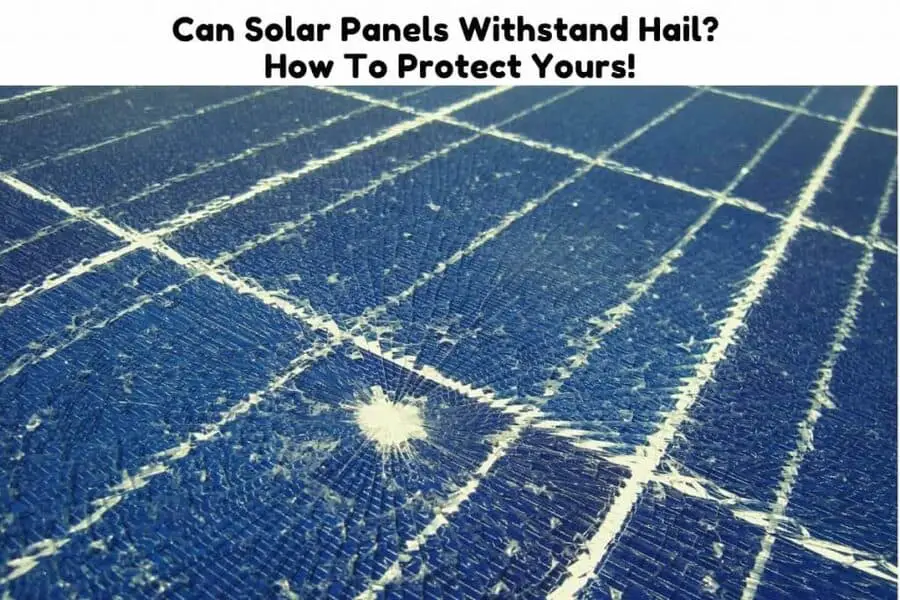High winds and hailstorms can cause serious property damage. Costs can run into the thousands for an individual homeowner. Between 2009 and 2019, hail-damage-related insured loss averaged between $8 to 14 billion dollars.
The roof is the most vulnerable part of a home in a hailstorm. With golf ball-size hailstones that can reach up to 120mph, your roof runs the hazard of major structural damage.
What happens when you have solar panels on the roof? Given that solar panels are partly made from glass, it is only reasonable to assume they run a greater risk of damage than a metal or asphalt roof. While this is a reasonable assumption, it is not entirely correct.
In this article, we will examine what happens to solar panels in hail. How durable are solar panels and can they withstand hail? We will also look at what other potential hazards solar panels face and what affect homeowner’s insurance has in the unlikely event solar panels do get damaged by hail.
On a side note! If you’re in need of a reliable and high-performance portable solar panel, We strongly recommend the Jackery SolarSaga 100W Portable Solar Panel (Amazon Link).
With a high conversion efficiency and foldable design, this solar panel is easy to transport and set up, making it perfect for outdoor activities like camping, hiking, and RV trips.

The US solar cell technology used in this panel ensures that you get the most efficient and reliable solar charging possible.
There is also a 60W option that is more affordable (Amazon Link)

Can a Hailstorm Break Solar Panels?
Hailstorms can damage solar panels but the likelihood of that happening is rare. Solar panels are made to withstand the harsh weather conditions they are exposed to outside. They are tested against impact damage, high temperatures, and strong wind force to ensure they are prepared for what they are exposed to on a roof.
Hailstorms can produce hailstones the size of baseballs. These stones can reach speeds of 120mph so there is some justification for concern at what damage an object that size moving at that speed could cause to a solar panel. Also, check out our post on “Can A Golf Ball Break A Solar Panel? What Can Crack it !“
But just how worried should you be?
How Well Do Solar Panels Do in Hail?
Solar panels are designed to withstand impact force. Most solar panels are tested and certified to handle hail up to one inch in diameter and fall at 50 mph. Solar cells are encased in durable glass to protect them from impact and insulate them from heat and water. As such solar panels have a warranty of 25 years.
In a severe 2017 hailstorm in Denver, Colorado 3,168 solar panels were pelted with hailstones up to 2.75 inches in diameter. Numerous cars and windows suffered extensive damage but of the more than 3,000 solar panels in the storm, only one was damaged. (Source)
Solar panels are subjected to stringent testing before they are certified and can leave the manufacturer’s factory. These tests simulate what the solar panels will be exposed to out in the field.
A solar panel is three layers of silicone protected by a layer of tempered glass. Tempered glass is either thermally or chemically manufactured and is about six times stronger than ordinary plate glass.
Furthermore, there are three grades of solar panels. They are graded based on the raw materials, time and research put into their development and build. Tier one solar panels are the highest quality and most durable.
The International Photovoltaic Quality Assurance Task Force (PVQAT) is an organization that develops standardized tests and certifications for the solar industry. They test solar panels to ensure they can hold up in different climate conditions. They also ensure quality control in the manufacturing process as well as the installation of solar panels. (Source)
What Can Damage Solar Panels?
Solar panels can get damaged by shading, thermal shock, and dirt. These are the primary risks a solar panel has. Damage can be in the form of cracking of the glass cover or failure of the solar cells.
Solar panel degradation
The biggest factor that can damage a solar panel is the sun itself. It might sound strange but exposing a solar panel to sunlight damages it a little. This is called degradation. Solar panel degradation occurs in all solar cells and happens as soon as you expose the solar cell to light. In other words, it is unavoidable unless you plan on keeping your solar panels wrapped up.
Degradation is the natural wear and tear specific to solar cells. Over time they start to produce less energy. Ordinarily, this happens at such a slow rate to not be of much concern. The rate of degradation ranges between 0.5 to 0.8% per year. What this rate means is that even after 25 years your solar panels should still be producing about 80% of their maximum energy output. (Source)
Shading
Shading will reduce the power output of your solar panels and eventually cause the failure of the solar panel if the shading happens consistently. This is because solar cells in shade can act as internal resistance and cause other solar cells or panels to heat up and consequently fail.
Thermal shock
Thermal shock is cracking caused by extreme temperature variations. When any material rapidly cools and heats up, it is liable to break from the action of rapid temperature change.
Dirt
Dirt is the most common way in which most solar panels get damaged. Dust and grime can act like shading on a solar panel. They can prevent or reduce a solar panel’s absorption of sunlight.
Corrosion
There is also the natural corrosion caused by exposure to outside conditions. Salt in the air and snow, heat, and water corrode the material structure of a solar panel. This is typically more pronounced in coastal areas.
How Do You Protect Solar Panels from Damage?
The key ways to protect solar panels are to have them installed properly, regularly inspect them and have them cleaned once every six to twelve months.
Other than that, there are several other things you can do to keep your solar panels in optimum condition.
- Use a protective cover over your solar panels.
- Coat the solar panels in a layer of Methacrylate.
- Follow your local weather forecast for storm predictions.
Are Solar Panels Covered by Homeowners’ Insurance?
Solar panels are covered by your homeowner’s insurance if they are permanently attached to your home. The specifics of your insurance are dependent on whether your solar panels are attached to your roof or some other structure in your home.
If your solar panels are attached to your roof then they are insured for damage in terms of the dwelling coverage. Solar panels on a detached structure like a tool shed may be insured in terms of the other structures’ coverage of your policy.
You should double-check to make sure your policy covers wind or hailstorm damage as some insurers do not cover that type of damage.
